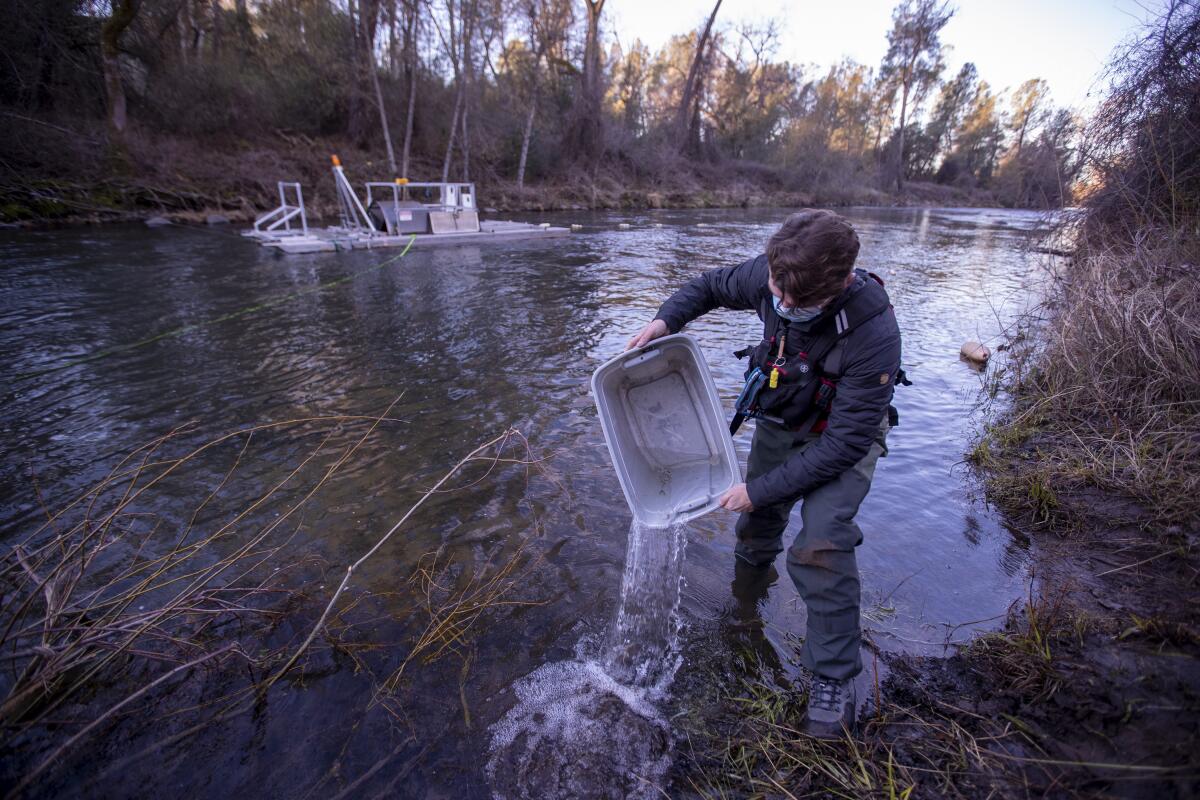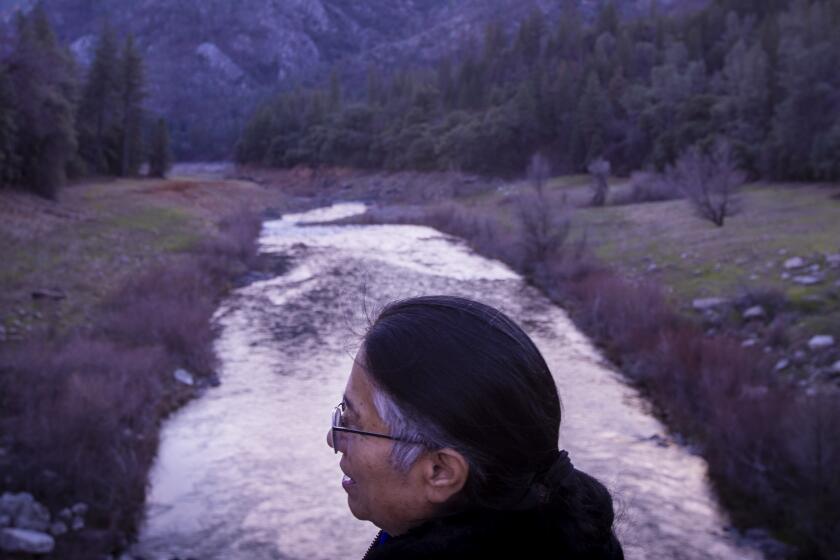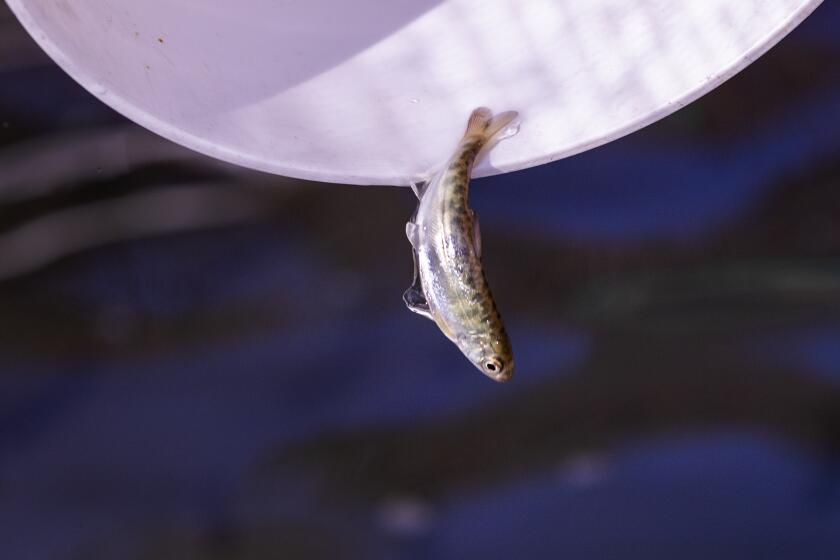Plummeting salmon population could trigger closure of fishing season in California waters

- Share via
California Chinook salmon populations have fallen to their lowest levels in years, according to new estimates released by state and federal scientists — a decline that could trigger a shutdown of the commercial and recreational fishing season along the coast.
“The salmon are struggling,” said Chuck Bonham, director of the California Department of Fish and Wildlife. “And we have great concern about their future, knowing we are fully committed to rebuilding them and saving them.”
Bonham said the decline is part of a decades-long trend, and the last three years of record drought “only further stressed our salmon populations.”
‘A glimmer of hope’: Tribe offers prayers for endangered Chinook salmon as eggs are returned to the McCloud River for the first time since the 1940s.
The department said scientists estimated that the number of 3-year-old fall-run Chinook likely to return to the Sacramento River this year to spawn would be fewer than 170,000, one of the lowest forecasts in 15 years. They also estimated that fewer than 104,000 are likely to return to the Klamath River, the second-lowest estimate since 1997.
In its announcement Wednesday, the department said returning fall-run Chinook “fell well short of conservation objectives” in the Sacramento River last year, and may now be approaching a point of being declared overfished.
“In response, federal and state agencies are expected to take a conservative approach when approving 2023 salmon seasons to provide additional protective measures to these stocks, and very limited or no fishing in 2023 appears possible,” the department said.
The new population estimates appear to reflect the variety of threats weighing on Chinook salmon. While the construction of numerous dams on ancestral rivers decades ago dealt a serious blow to the species’ survival, global warming and drought have also exacted a toll — even as state and federal hatcheries rear and release millions of salmon each year.
Salmon, which begin their life cycle in stream beds, migrate to the ocean as juveniles, and then return to their birthplace to spawn before dying. In recent years, scientists have identified yet another threat to the species’ survival — a deficiency of thiamine is harming Chinook populations, and researchers suspect salmon may be feeding too heavily on numerous anchovies in the Pacific Ocean.
In light of the new population estimates, the Pacific Fishery Management Council will consider alternatives for the ocean fishing season during meetings next week.
The options probably will include a limited fishery, a complete shutdown or something in between, Bonham said. A decision is expected during meetings in early April.
California has banned coastal salmon fishing only once before. That closure occurred in 2008.
Last year’s commercial season included a range of permitted dates from May to October in different zones along the coast, while the Klamath zone in far Northern California was closed.
Recreational anglers catch fall-run Chinook on the Sacramento and other rivers, and members of Native tribes traditionally fish for salmon.
Decisions on inland recreational fishing will be made in May by the California Fish and Game Commission.
Data from previous years show that estimates of returning salmon are typically low three years after dry conditions, Bonham said.
The low numbers this year reflect the extremely dry conditions of 2020, he said.
Salmon numbers are sporadic and tied to flows in rivers, with wetter conditions helping the fish flourish.
Bonham said the extremely wet winter this year should benefit the salmon. In 2010, for example, ample rainfall led to higher estimates of returning adults in 2012 and 2013.
“That gives you some optimism that in three years from now, you could see the same kind of thing,” Bonham said. “This can turn around.”
Winter-run Chinook salmon numbers are at the lowest they’ve ever been. But scientists say it’s not because of high temperatures or the historic drought. Instead, they say, it’s their diet.
Salmon fishing advocates, however, said the dire outlook for this year shows that Gov. Gavin Newsom’s administration should do more to prioritize river flows for fish.
The forecast of too few fish to support a fishery “will hurt not only those who make a living tied to salmon but also the many Californians whose dinner tables would normally be supplemented by salmon,” said John McManus, president of the Golden State Salmon Assn.
McManus and other leaders of the association criticized Newsom’s water policies, noting that while salmon numbers have declined, water has flowed to almond orchards that have expanded substantially in recent years.
“We’ve still got good water resources in California. They just need to be managed right, in a little bit more fair and balanced way, so we don’t crush the native salmon runs that the state has been blessed with. And this year, we can see they’ve been crushed,” McManus said.
He said the association’s members support responsible stewardship.
“Fishermen and women throughout the state want to see this stock rebuilt,” McManus said. “We know it can be. It just takes a little bit of fairness, compromise and balance.”
Last month, environmental and fishing advocates condemned a request by the Newsom administration to temporarily waive environmental water-quality rules in the Sacramento-San Joaquin River Delta in an effort to store more water in reservoirs. They argued that the request, which was approved by the State Water Resources Control Board’s executive director, will be harmful for Chinook salmon, longfin smelt and endangered delta smelt.
State officials have defended the approach, saying other existing protections are adequate.
Department of Fish and Wildlife officials said they are working toward plans aimed at rebuilding fall-run Chinook populations in the Sacramento and Klamath rivers.
But environmental advocates argue that the state’s efforts are insufficient, and this year’s low numbers reflect a trend of continuing declines.
“It’s pretty heartbreaking,” said Doug Obegi, a senior attorney with the Natural Resources Defense Council. “I think it certainly should be a big warning light that our native salmon runs are in deep trouble.”









